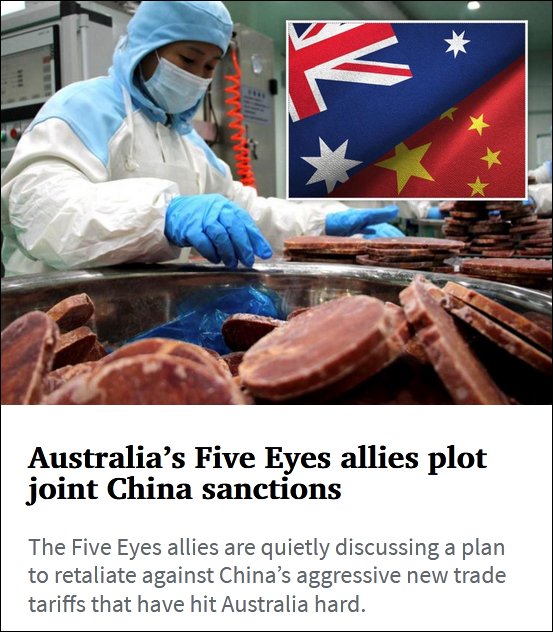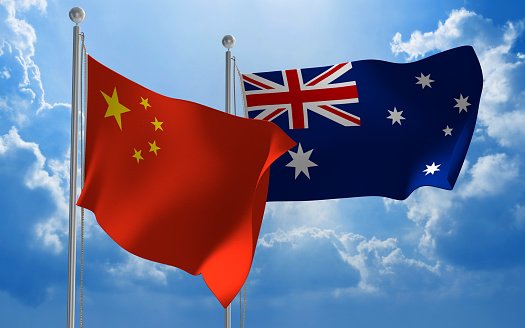The export of her products to China has been blocked one after another. Australia, helpless, wanted to report to the rest of the “Five Eyes Alliance” to warm up.
The British Daily Mail and other media quoted News Corp as reporting on December 13 that the “Five Eyes Alliance” is quietly negotiating a plan to jointly impose “retaliatory sanctions” on Chinese products in order to counter China’s trade restrictions on Australia.
According to news obtained by News Corporation, one of the ways discussed by the “Five Eyes Alliance” national officials is that Australia, the United States, the United Kingdom, Canada and New Zealand each introduce sanctions on Chinese goods.
Another approach is that Australia imposes retaliatory tariffs on products from China.
If China considers making up for losses from other places, the four allies of the United States, Britain, Canada and Singapore will refuse to buy related products from China to support Australia.
According to the plan under negotiation, the security agencies of the Five Eyes Alliance will jointly evaluate each of China’s sanctions on Australia’s exports.
If the measures are considered to put pressure on Australia “for political purposes”, the Five Eyes Alliance will impose “retaliatory sanctions”.

The report said that although the negotiations are still in the preliminary stage, the plan has been paid more and more attention in Canberra, and Washington is also “seriously considering”.
According to sources, the cooperation of the “Five Eyes Alliance” is very good at present. Anne Ruston, the Australian Minister of Family and Social Services, has recently been linked to the ministers of the “Five Eyes Alliance” countries on this matter.
Fergus Hanson, director of the International Cyber Policy Center of the Australian Institute for Strategic Policy (ASPI), mentioned in a recent report that the “Five Eyes Alliance” can refer to NATO’s commitment to Article V on “collective defense”, that is, attacks on an ally can It is regarded as an attack on all allies.
In an interview with News Corporation, Hansen continued to stir up trouble, saying that the current measures of the Five Eyes Alliance against China cannot solve the problem and are a failed strategy. He threatened that adopting “retaliatory sanctions” would put China under the same pressure to ensure that China “recognized that sanctions are two-way”.
“Organizing a group” against China is not just Australia’s small abacus. As early as November 23, the Wall Street Journal quoted senior U.S.
government officials as saying that the Trump administration is planning to establish an informal alliance of Western countries to “use trade power to coerce” others in China. When the state is concerned, it can “jointly counterattack”.
The “countermeasure” of the above-mentioned plan is similar to the version disclosed by News Corporation, including that when China “boycotts” imports from a country, the allies involved in the plan will agree to buy the boycotted goods or provide compensation.
Alternatively, allies can join forces to impose tariffs on China on lost trade.
At that time, U.S. officials claimed that the reason for the Trump administration’s brewing of the plan was “economic pressure” on Australia after “Australia’s call for an investigation into the source of the coronavirus”.
However, the report pointed out that the plan faces a lot of uncertainty. After all, it is not clear whether the Biden administration will support it in the future, and the actions may violate the provisions of the World Trade Organization (WTO).
It is worth noting that some “Five Eyes Alliance” countries are also beneficiaries of the obstruction of Australia’s merchandise exports to China. Perhaps the exporters of these countries are eager to replace Australia.
For example, On December 1, Andrei Agapi, deputy director of Asia-Pacific agricultural pricing at S&P Global Platts, said in an interview with CNBC that China imports wheat and jade. Alternative sources of supply have been found on crops such as rice and soybeans – Australia’s “partner” the United States.
In addition, Canada is also interested in China’s coal market. Donald R. Lindsay, CEO of Canada’s largest diversified natural resources company, revealed that the company is adjusting its sales books and hopes to increase its coking coal exports to China next year.
Lindsay revealed that using the opportunity of Australian coal ships to “stay in Chinese ports”, Tek Resources aims to export about 7.5 million tons of coking coal to China next year.Click to enter the topic:



